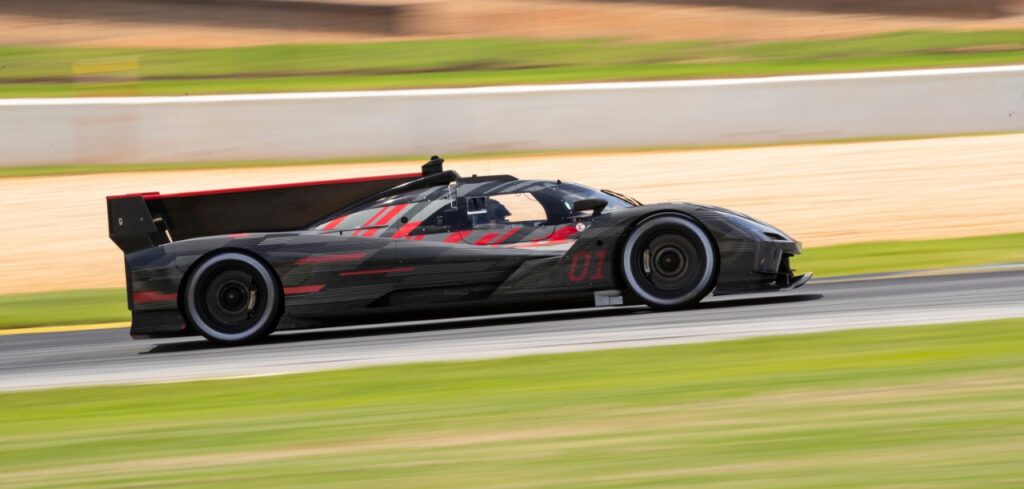With 2023 drawing closer, pressure is ramping up on manufacturers looking to debut their new LMDh machinery in IMSA’s GTP class and the WEC. Laura Klauser Wontrop, GM sports car racing program manager, recently gave an update on progress with the Cadillac LMDh following a three-day group test at Road Atlanta.
According to Wontrop, the test was a success, despite some downtime for the car. “You never get everything you want because you show up with these crazy, ambitious test plans,” she said. “But, I’d say, everyone was pleased with our time at the track. We’re making major progress with the car. We transitioned from getting it to run to testing a couple of tests ago and now we’re full steam ahead of working through our plan. The more miles we put on the better from a durability perspective and checking all of our parts.”
The team is apparently deep into the homologation process for the car with IMSA, the FIA and ACO, but its key target is completing a 24-hour test before the end of the year. “We’ve been busy getting through the wind tunnel and the things we do on the homologation side,” noted Wontrop. “But really our next big thing that we’re working toward is we’d like to do a 24-hour test before the end of the year. You learn the most when you do those. We’re excited to see how the car does, making sure we have all the representative parts on the car for that to make sure that test is successful.
“If you look at the timeline between now and January when we are racing, we better be at least 50% through. The things that are mission critical to get ready for January I’d say we are about a tick more than halfway through those items, and then there’s looking beyond January and the things we’ll be doing in the WEC we have a list for that as well. We’re prioritizing getting the car ready for Rolex just because that comes first and then we’ll look at the WEC schedule and the unique things that WEC tracks bring to the equation.”
Wontrop went on to explain that the team’s understanding of the hybrid system is constantly developing. “It’s evolving daily. We’re working on the simulation side and understanding and figuring out across the class what’s the plan. Some of that is still in motion. It’s probably the most exciting part – all of the opportunities. We can drive the car in electric mode. We can launch it, so you can see the true hybrid coming out. Where we evolve and how that works from the fuel economy standpoint versus other usefulness of having an electric motor on the car is what is going to make the class interesting. How each OE approaches that and how we change our strategy as we learn more.”
Addressing the level of control each manufacturer has over the hybrid energy deployment and installation, she said, “There is the equity model that all of us must run to that defines a lot of parameters on how we can use it and basically where and when. I think there is a little freedom in how we’re integrating everything and when we want to use the power coming off the hybrid versus engine power, or both or mix that. That’s where a lot of the learning is happening and working through things well past January because there is a lot to look at. There is some opportunity to have some identity from each OE’s perspective, but they’ve done a lot of work to make sure that they keep it parity as much as they can so that we don’t end up in a situation where one car is completely off in the weeds either positively or negatively and the rest are not. It’s evolving and we’re excited to find out all the things we can do.”
She also highlighted that the cooperative approach between various manufacturers is continuing: “We are working together. Not so much that we’re helping tune each other’s cars, but there is a lot of alignment for handling all the things that this post-pandemic world has thrown at us from parts supply shipping and other things. We are keeping dibs on each other in terms of ‘How are you doing? Can you make it to the test? Can we share resources? Can we talk to the supplier to send us whatever it is and see if they can bundle it?”
Moving on to the aero development of the car, Wontrop noted that the homologation performance window was tighter than with the previous DPi machinery: “The window that they’ve given us for the aero map that we have to fit in is quite small compared to things we’ve done in the past. And I think important because that’s what is going to help get the cars close to each other despite the fact that each one looks so different from each other. That’s good in terms of getting them set up for good racing.”
Expanding on the aero development process, she said, “Starting with the scale wind tunnel – and a lot of that came from creating the body shape – we would check our ideas and still putting the car where it needs to be. When we had our first real full-scale race car, we started doing work in the big wind tunnels. The hybrid is weight to the car, so we need to keep an eye on that as we look at performance. But with that map being so small, our number one target is getting there and the rest falls into place.”



